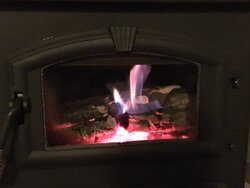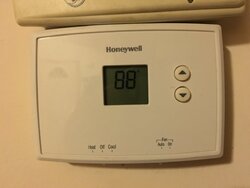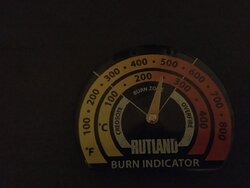I really dont know where to begin. Ill post set up and go from there I guess..
Through wall kit, 18' class A
2.5'-3' above ridge
3' horizontal run from flue to exterior
another 2.5' vertical flue off stove
one 90 elbow inside
one 90 elbow outside for chimney
Stove is US Stove 2000
I have been using an old 1982 coal/wood stove. had no baffle and made one with 1/4 inch steel. the draft was crazy strong and that stove had 3 elbows because it was a rear vent. That stove would destroy wood in 2 hours or less. This new stove is a top vent.
Picked up new stove with tax refund. Installed and it cranked it up.
The air control no matter what setting I set it at seems like it is blowing the flames out. Too much air being thrown in? I cant seem to get that lazy fire effect. The air coming in is blowing either much or not enough at times. I open the door a tiny crack and the fire goes nuts to a point where it might over fire. Once I did get the flue temp over 500 degrees but nothing glowed red, everything was fine and just lowered the intake and down went the temps. But then the flames started dying out. it was a balancing act trying to keep it from overfiring and maintaining flame for the efficiency.
Then, when I open the door to adjust the logs I do get some smoke spillage. Doesnt seem bad. I open the air completely, crack the door for a few seconds. You can see the smoke rolling off the top and bouncing off the glass going into the fire. So, I open the door and the smoke spills into the room. Its not a lot but it seems as if the air intake is not letting the smoke go up the front and instead is pushing it back down and out into room instead of into fire because the door is open.
Am I supposed to close the air when I open the door? Manual says otherwise. Not sure.
I also do not get the secondaries running. I only got it running one time when the flue temps were rising over 500. Sounds like I am not getting the stove hot enough maybe? Its a tough call because there is no overfiring temperature to look for in the manual. I called US Stove and the rep wasnt sure what temp to avoid. I pretty much try to keep it under 600... if I can.
When the stove doesnt get hot enough the only way for me to get the secondaries running is to open the door for a minute... close the door and air and then the secondaries go off from the tubes but it only lasts a short while. Maybe 2 minutes.
Im just afraid to get this thing too hot. It sounds like Im not running it right looking at this now lol
I think I might be stacking the wood wrong inside the box also. It really sucks to be new
Through wall kit, 18' class A
2.5'-3' above ridge
3' horizontal run from flue to exterior
another 2.5' vertical flue off stove
one 90 elbow inside
one 90 elbow outside for chimney
Stove is US Stove 2000
I have been using an old 1982 coal/wood stove. had no baffle and made one with 1/4 inch steel. the draft was crazy strong and that stove had 3 elbows because it was a rear vent. That stove would destroy wood in 2 hours or less. This new stove is a top vent.
Picked up new stove with tax refund. Installed and it cranked it up.
The air control no matter what setting I set it at seems like it is blowing the flames out. Too much air being thrown in? I cant seem to get that lazy fire effect. The air coming in is blowing either much or not enough at times. I open the door a tiny crack and the fire goes nuts to a point where it might over fire. Once I did get the flue temp over 500 degrees but nothing glowed red, everything was fine and just lowered the intake and down went the temps. But then the flames started dying out. it was a balancing act trying to keep it from overfiring and maintaining flame for the efficiency.
Then, when I open the door to adjust the logs I do get some smoke spillage. Doesnt seem bad. I open the air completely, crack the door for a few seconds. You can see the smoke rolling off the top and bouncing off the glass going into the fire. So, I open the door and the smoke spills into the room. Its not a lot but it seems as if the air intake is not letting the smoke go up the front and instead is pushing it back down and out into room instead of into fire because the door is open.
Am I supposed to close the air when I open the door? Manual says otherwise. Not sure.
I also do not get the secondaries running. I only got it running one time when the flue temps were rising over 500. Sounds like I am not getting the stove hot enough maybe? Its a tough call because there is no overfiring temperature to look for in the manual. I called US Stove and the rep wasnt sure what temp to avoid. I pretty much try to keep it under 600... if I can.
When the stove doesnt get hot enough the only way for me to get the secondaries running is to open the door for a minute... close the door and air and then the secondaries go off from the tubes but it only lasts a short while. Maybe 2 minutes.
Im just afraid to get this thing too hot. It sounds like Im not running it right looking at this now lol
I think I might be stacking the wood wrong inside the box also. It really sucks to be new






